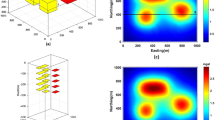Abstract
The proposed algorithm in this paper is the quantized minimum kernel risk hyperbolic secant adaptive filtering algorithm, which offers a simplified approach to enhancing the performance and stability of kernel adaptive filtering in non-Gaussian noise environments. The algorithm features a newly developed minimum kernel risk hyperbolic secant cost function, which harnesses the hyperbolic secant function’s strengths to diminish outlier impacts and expedite convergence. In addition, its convex kernel risk-sensitive loss surface facilitates swift and accurate filtering via gradient-based methods, thus ensuring outlier robustness. This method could effectively manage network size and reduce computational complexity by incorporating vector quantization for inputting spatial data. Simulation tests in Mackey–Glass time series prediction and nonlinear system identification have indicated that the minimum kernel hyperbolic secant adaptive filtering algorithm and its quantized variant excel in terms of convergence speed, robustness, and computational efficiency.








Similar content being viewed by others
Data Availability
All data generated or analyzed during this study are included in this article. Data sharing is not applicable to this article as no datasets were generated or analyzed during the current study.
References
Zhong-Da, T., Xian-Wen, G., Tong, S.: Combination kernel function least squares support vector machine for chaotic time series prediction. Acta Physica Sinica (2014). https://doi.org/10.7498/aps.63.160508
Akrout, H., Crouzet, J.-F., Strauss, O.: Multidimensional possibility/probability domination for extending maxitive kernel based signal processing. Fuzzy Sets Syst. 367, 1–18 (2019)
Seo, B.: Joint design of precoder and receiver in cognitive radio networks using an MSE criterion. Signal Process. 91(11), 2623–2629 (2011)
Wu, Z., Peng, S., Chen, B., Zhao, H.: Robust Hammerstein adaptive filtering under maximum correntropy criterion. Entropy 17(10), 7149–7166 (2015)
Chen, B., Wang, J., Zhao, H., Zheng, N., Principe, J.C.: Convergence of a fixed-point algorithm under maximum correntropy criterion. IEEE Signal Process. Lett. 22(10), 1723–1727 (2015)
Zhao, S., Chen, B., Principe, J.C.: Kernel adaptive filtering with maximum correntropy criterion. In: The 2011 International Joint Conference on Neural Networks. IEEE, pp. 2012–2017 (2011)
Wu, Z., Shi, J., Zhang, X., Ma, W., Chen, B., Senior Member, I.: Kernel recursive maximum correntropy. Signal Process. 117, 11–16 (2015)
Chen, B., Principe, J.C., Hu, J., Zhu, Y.: Stochastic information gradient algorithm with generalized Gussian distribution model. J. Circuits Syst. Comput. 21(01), 1250006 (2012)
He, Y., Wang, F., Yang, J., Rong, H., Chen, B.: Kernel adaptive filtering under generalized maximum correntropy criterion. In: 2016 International Joint Conference on Neural Networks (IJCNN), pp. 1738–1745 (2016). IEEE
Chen, B., Xing, L., Xu, B., Zhao, H., Zheng, N., Principe, J.C.: Kernel risk-sensitive loss: definition, properties and application to robust adaptive filtering. IEEE Trans. Signal Process. 65(11), 2888–2901 (2017)
Platt, J.: A resource-allocating network for function interpolation. Neural Comput. 3(2), 213–225 (1991)
Csató, L., Opper, M.: Sparse on-line gaussian processes. Neural Comput. 14(3), 641–668 (2002)
Engel, Y., Mannor, S., Meir, R.: The kernel recursive least-squares algorithm. IEEE Trans. Signal Process. 52(8), 2275–2285 (2004)
Liu, W., Park, I., Principe, J.C.: An information theoretic approach of designing sparse kernel adaptive filters. IEEE Trans. Neural Netw. 20(12), 1950–1961 (2009)
Yule, G.U.: Notes on the theory of association of attributes in statistics. Biometrika 2(2), 121–134 (1903)
Zhao, S., Chen, B., Zhu, P., Príncipe, J.C.: Fixed budget quantized kernel least-mean-square algorithm. Signal Process. 93(9), 2759–2770 (2013)
Bhattacharjee, S.S., Kumar, K., George, N.V.: Nearest Kronecker product decomposition based generalized maximum correntropy and generalized hyperbolic secant robust adaptive filters. IEEE Signal Process. Lett. 27, 1525–1529 (2020)
Huo, Y., Tuo, L.-H., Qi, Y., Ding, R.: Kernel minimum logarithmic absolute deviation adaptive filtering algorithm based on p-norm. J. Phys. 71(277)
Aalo, V.A., Ackie, A.-B.E., Mukasa, C.: Performance analysis of spectrum sensing schemes based on fractional lower order moments for cognitive radios in symmetric \(\alpha \)-stable noise environments. Signal Process. 154, 363–374 (2019)
Bhatia, V., Mulgrew, B., Georgiadis, A.T.: Stochastic gradient algorithms for equalisation in \(\alpha \)-stable noise. Signal Process. 86(4), 835–845 (2006)
Funding
This work was supported by science and technology program of Gansu Province(No.21JR7RA120), the National Natural Science Foundation of China(No.61862041).
Author information
Authors and Affiliations
Contributions
HY proposed the innovative points of the paper, while HZ and HY co-wrote the main manuscript text. QY and LJ were responsible for drawing Figs. 1, 23 and the algorithm flowchart. HY and LZ were responsible for drawing Tables 1, 2 and 3. All authors reviewed the manuscript.
Corresponding author
Ethics declarations
Conflict of interest
All authors disclosed on relevant relationships.
Additional information
Publisher's Note
Springer Nature remains neutral with regard to jurisdictional claims in published maps and institutional affiliations.
Rights and permissions
Springer Nature or its licensor (e.g. a society or other partner) holds exclusive rights to this article under a publishing agreement with the author(s) or other rightsholder(s); author self-archiving of the accepted manuscript version of this article is solely governed by the terms of such publishing agreement and applicable law.
About this article
Cite this article
Yibo, H., Zhiling, H., Yuanlian, H. et al. A quantized minimum kernel risk hyperbolic secant adaptive filtering algorithm. SIViP (2024). https://doi.org/10.1007/s11760-024-03072-w
Received:
Revised:
Accepted:
Published:
DOI: https://doi.org/10.1007/s11760-024-03072-w




